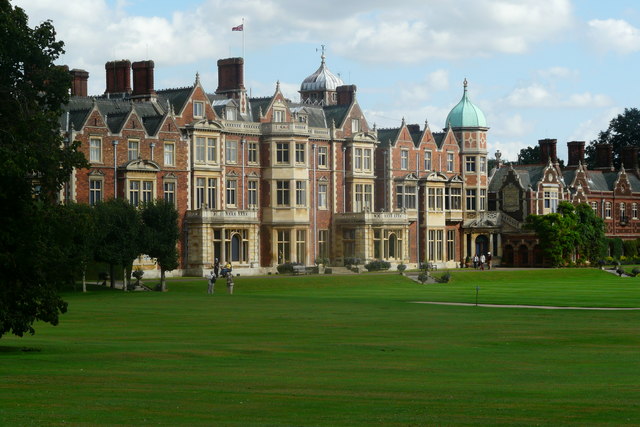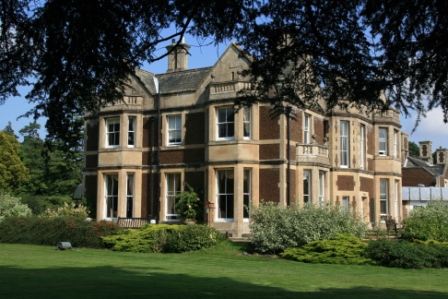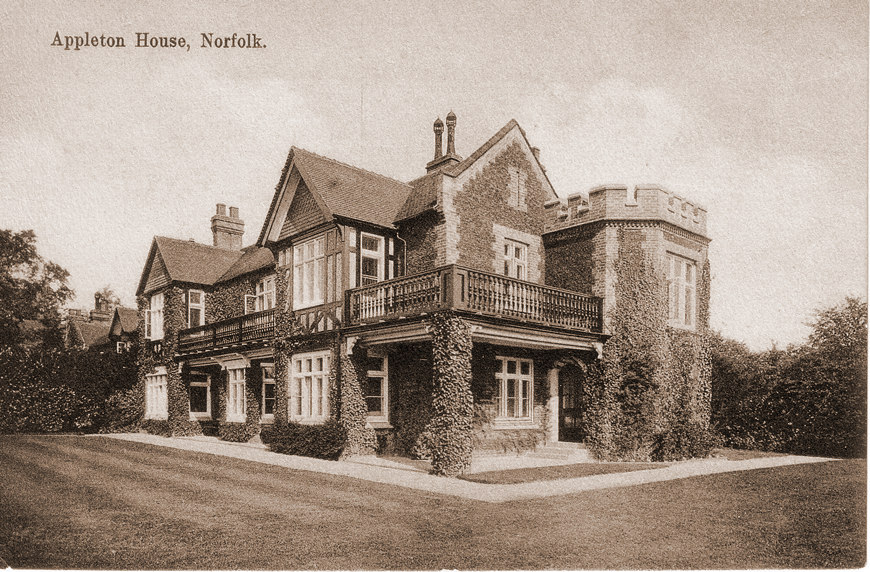by Scott Mehl
© Unofficial Royalty 2015

By John Fielding – This file has been extracted from another file: Sandringham House from the air.jpg, CC BY 2.0, https://commons.wikimedia.org/w/index.php?curid=72040973
Sandringham House
Sandringham House, located on the 20,000 acre Sandringham Estate in Norfolk, is The Queen’s privately owned home. Originally purchased as a home for King Edward VII, it remains a favorite residence of The Queen, where she spends several months each year. The large Sandringham Estate is also the home to several other current and former royal residences, including York Cottage, Park House, Appleton House (demolished in 1984), and Anmer Hall which is currently the country home of The Duke and Duchess of Cambridge. In addition, over half of the estate is leased out as farmland. Like Balmoral Castle, Sandringham is owned privately by the Sovereign, and not part of the Crown Estate. It is privately managed by an estate agent and includes two studs, a fruit farm, and a public country park.
The house was purchased for the future King Edward VII in the spring of 1862, with its surrounding estate of nearly 6,900 acres (at that time), from Charles Spencer Cowper. Having come of age, Edward was given Marlborough House in London as his principal residence, but it was deemed important that he should have a country home as well. His father, Prince Albert, had been conducting the search for a suitable home but passed away in December 1861. Queen Victoria insisted that Albert’s work continue, and Edward himself visited Sandringham and decided that it was the most suitable home and quickly arranged for the purchase, for the then-staggering cost of £220,000.
At the time, the house was a plain Georgian building with a white stucco facade and had been built in the late 1700s. Edward took up residence shortly after his marriage to Princess Alexandra of Denmark in March 1863. Soon finding that the house was too small for their growing family, Edward had the house demolished and built a new grand house. The main house was finished in 1870, and further additions would follow: a ballroom in 1881, and a guest wing in the 1890s. The estate was also enlarged through the purchase of several neighboring farms and estates through the years.
Sandringham was used regularly for shooting, a favorite pastime of the future King Edward VII. He famously changed the clocks in the house set forward half an hour to allow for more light for hunting. This became widely known as Sandringham Time. The tradition continued until the accession of King Edward VIII in 1936.
Of Edward and Alexandra’s six children, only their youngest, Prince Alexander John, was born at Sandringham. Sadly, he died the following day. However, the house has been the site of several deaths in the royal family. Edward and Alexandra’s eldest son, Prince Albert Victor (Eddy), The Duke of Clarence and Avondale, died at the house in January 1892, just weeks after becoming engaged to Princess Mary of Teck.
Following King Edward VII’s death in 1910, Sandringham House remained the home of his widow, until her own death in 1925. At that point, King George V and Queen Mary were able to leave York Cottage on the estate, and take up residence in the main house. In 1932, King George V made the first Christmas broadcast to the Empire, via radio, which was broadcast live from the house. (And it was at Sandringham, 25 years later, when his granddaughter, Queen Elizabeth II, made her first televised broadcast from the library.) King George V passed away at Sandringham in January 1936.
After the abdication of King Edward VIII at the end of 1936, his successor, King George VI, was forced to purchase Sandringham (and Balmoral) from his elder brother, as Edward remained the owner of both. The new King and his family stayed at Sandringham often, and during World War II, the two young princesses spent large amounts of time on the estate. It was here that the King succumbed to cancer and died in his sleep on February 6, 1952.

source: Wikipedia, Elwyn Thomas Roddich
Each year, during the reign of Queen Elizabeth II, most members of the Royal Family spent Christmas at Sandringham. After everyone arrived (on a very specific timetable based on precedence), the family gathered in the White Drawing Room for tea, while finishing touches are made to the Christmas tree. Presents, displayed on tables in the nearby Red Drawing Room, were opened. Then, following drinks, a formal dinner was served in the Dining Room.
On Christmas Day, the entire family attended church at Saint Mary Magdalene Church on the estate. Most of the family walked from the house, while Queen Elizabeth II arrived by car. Over the next few days, nearly all of the royal family returned home, but Queen Elizabeth II and her husband Duke of Edinburgh remained at Sandringham, making it their base until early February. Queen Elizabeth II traditionally spent her Accession Day – February 6 – at Sandringham before returning to London.
As mentioned, there are several other current and former royal residences on the estate.

York Cottage. source: Wikipedia
York Cottage was the home of King George V and Queen Mary from the time of their marriage in 1893, and where most of their children were born. Today, it is used as offices for the estate.

Park House. source: The Sandringham Estate
Park House was the birthplace of Diana, Princess of Wales. Read more about Park House here!
Appleton House was given to Princess Maud, the daughter of King Edward VII, upon her marriage to the future King Haakon VII of Norway. It was also the birthplace of their son, the future King Olav V, in 1903. After Maud’s death, King Haakon returned the house to the royal family, and it was used occasionally to house visiting members of the royal family. After years of not being used, the house was torn down in 1984.

Amner Hall; Credit – By Richard Humphrey, CC BY-SA 2.0, https://commons.wikimedia.org/w/index.php?curid=39950853
Anmer Hall is currently the country home of The Prince and Princess of Wales. Previous residents also include the Duke and Duchess of Kent, who leased the property from 1972 until 1990.
Learn more about the other British Royal Residences here!
This article is the intellectual property of Unofficial Royalty and is NOT TO BE COPIED, EDITED, OR POSTED IN ANY FORM ON ANOTHER WEBSITE under any circumstances. It is permissible to use a link that directs to Unofficial Royalty.

